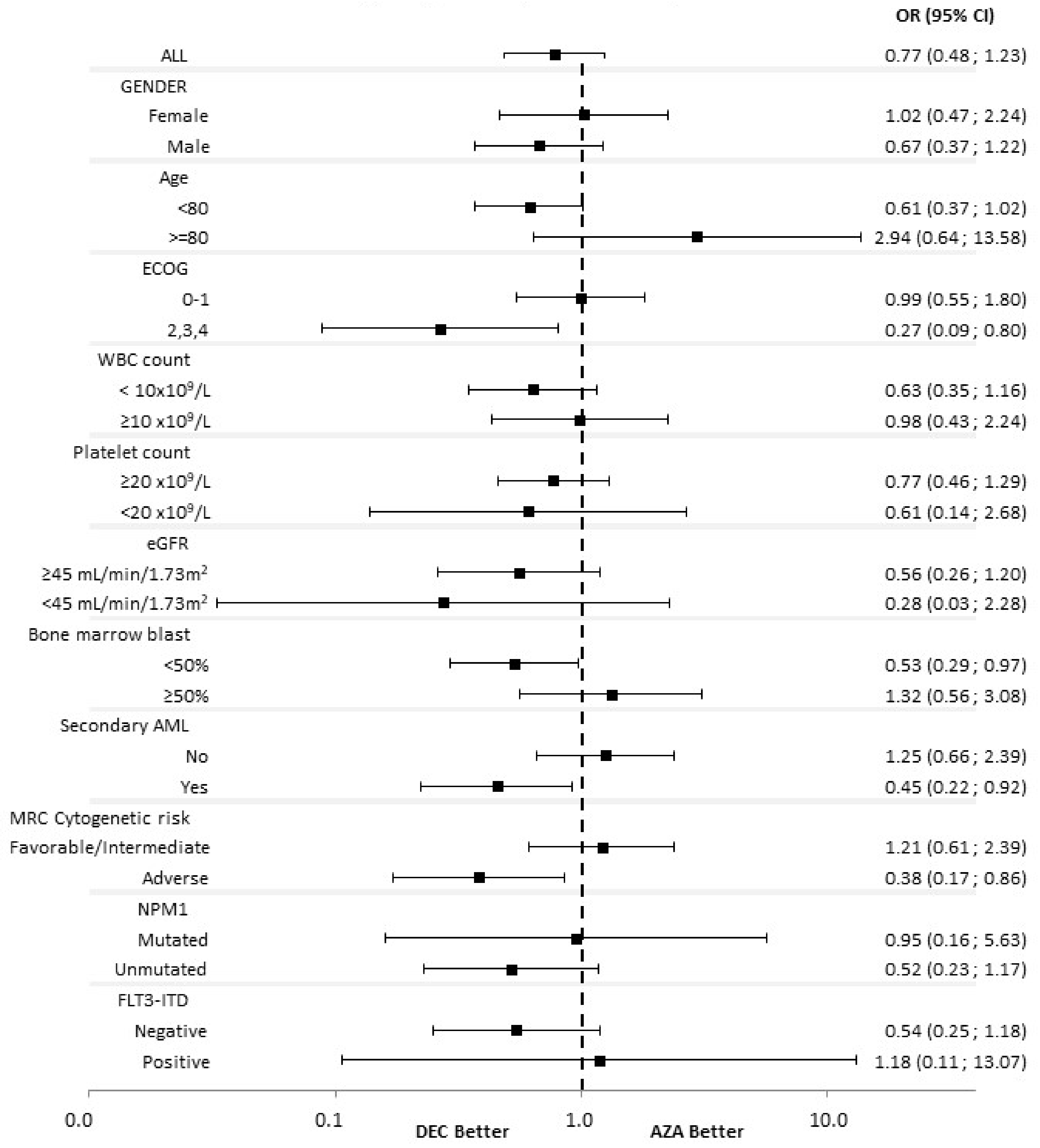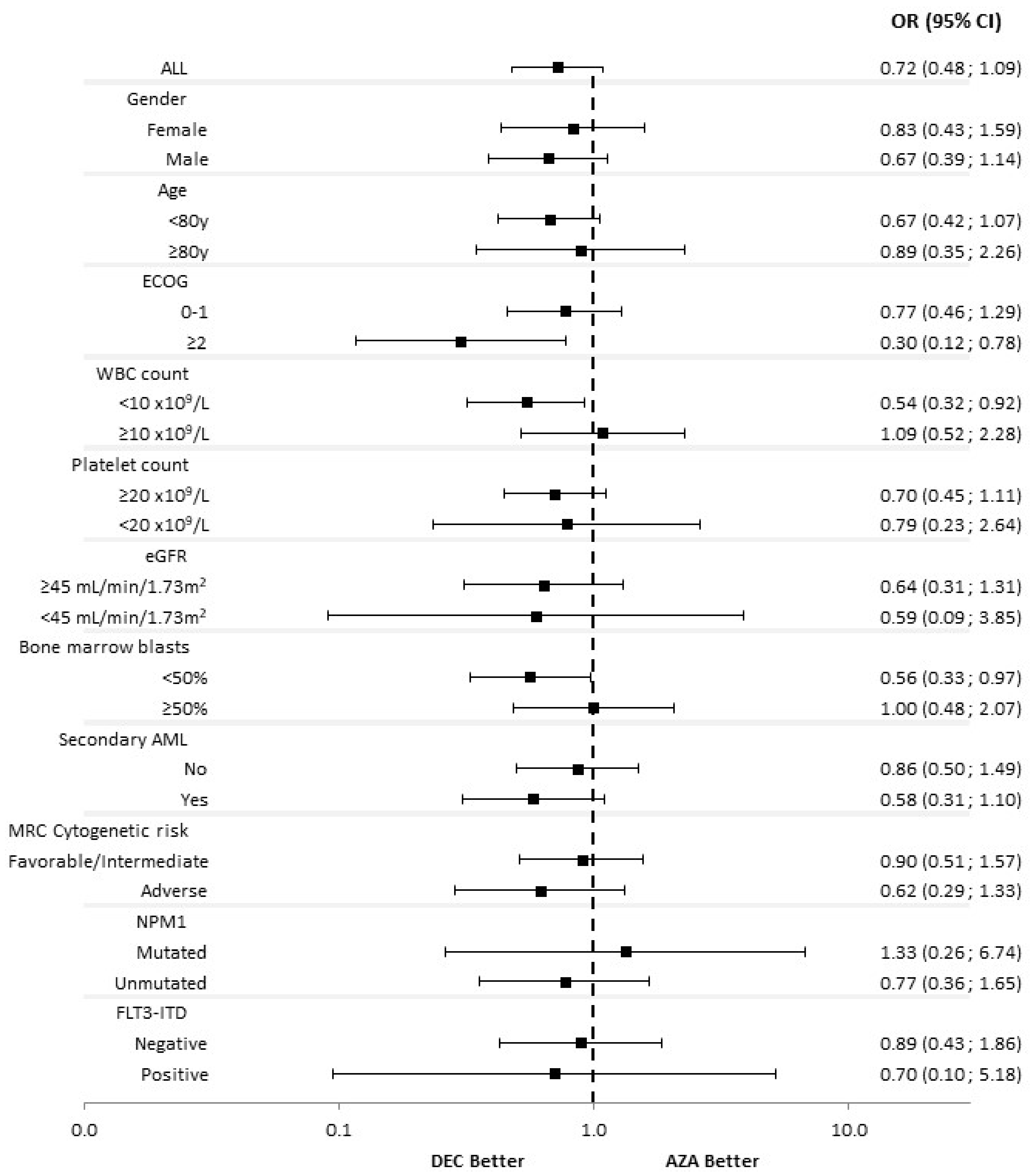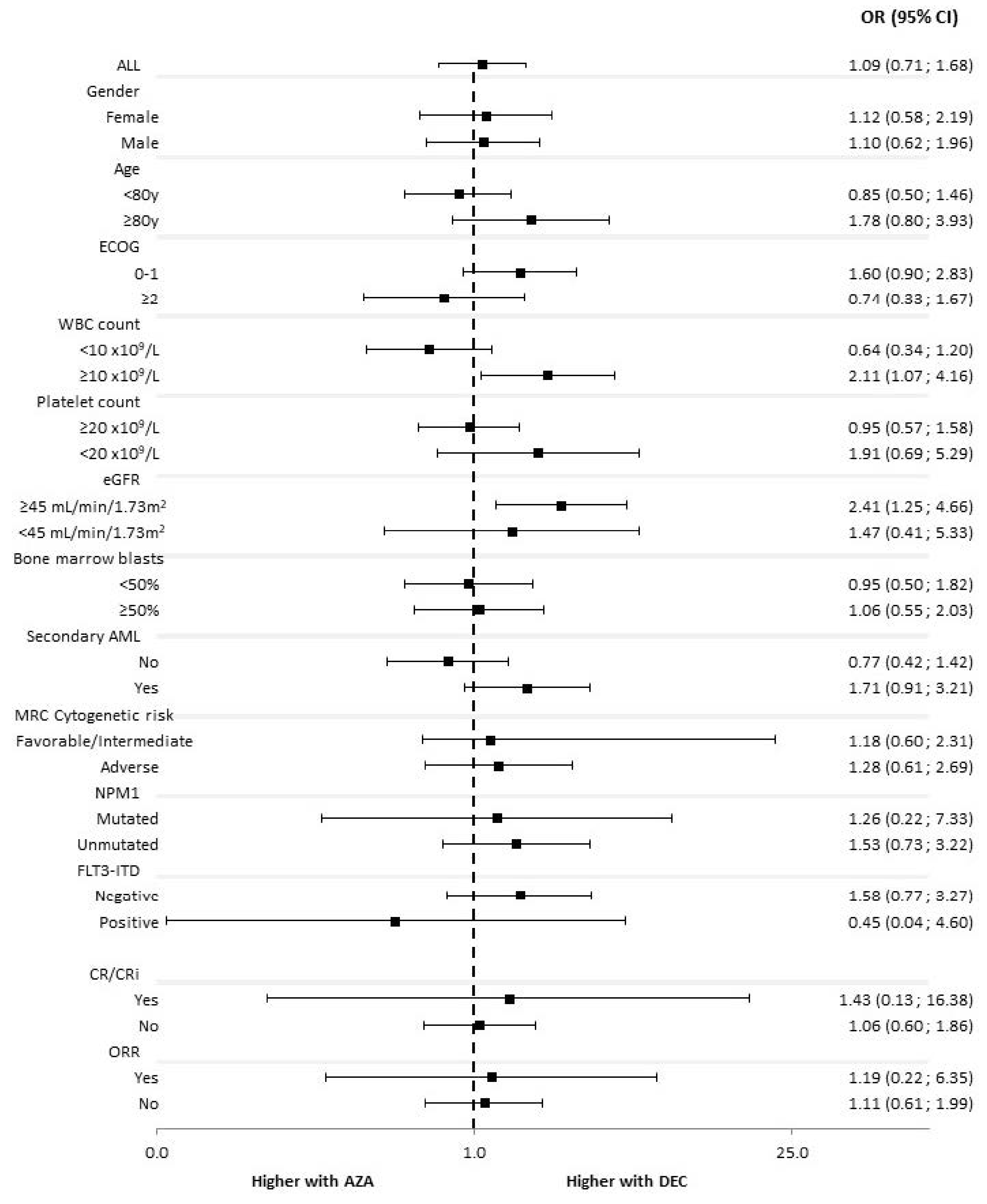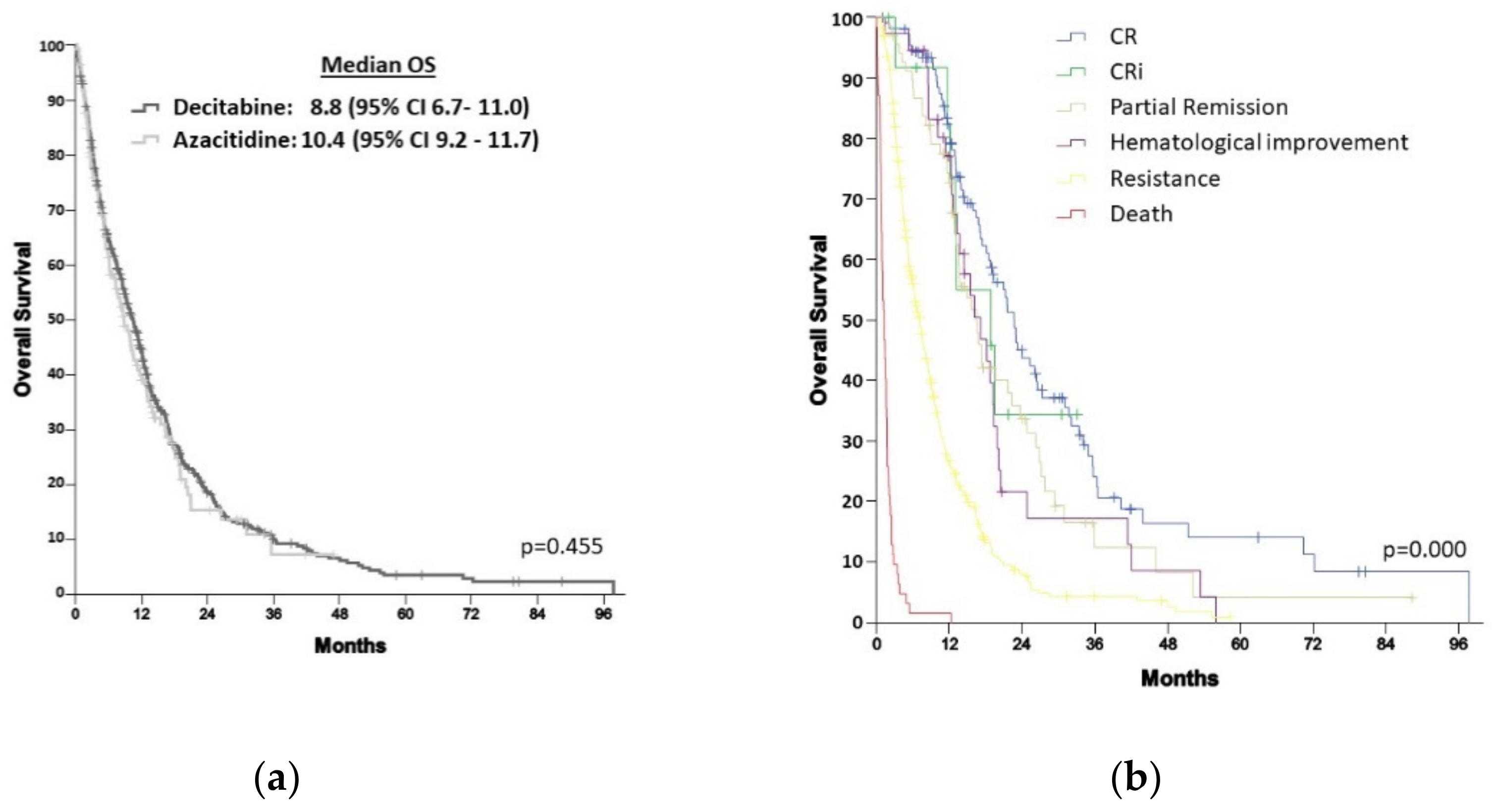Azacitidine vs. Decitabine in Unfit Newly Diagnosed Acute Myeloid Leukemia Patients: Results from the PETHEMA Registry
Abstract
:Simple Summary
Abstract
1. Introduction
2. Patients and Methods
2.1. PETHEMA Registry
2.2. Eligibility
2.3. Treatment Schedules
2.4. Study Definitions and Endpoints
2.5. Statistical Analysis
3. Results
3.1. Accrual and Patient Characteristics
3.2. Short-Term Outcomes
30, 60 and 120-Days Mortality
3.3. Long-Term Outcomes
3.3.1. Overall Survival
3.3.2. Other Time-to-Event End Points
3.4. Salvage Therapy
4. Discussion
5. Conclusions
Supplementary Materials
Author Contributions
Funding
Institutional Review Board Statement
Informed Consent Statement
Data Availability Statement
Acknowledgments
Conflicts of Interest
References
- Short, N.J.; Rytting, M.E.; Cortes, J.E. Acute Myeloid Leukaemia. Lancet 2018, 392, 593–606. [Google Scholar] [CrossRef]
- Döhner, H.; Estey, E.; Grimwade, D.; Amadori, S.; Appelbaum, F.R.; Büchner, T.; Dombret, H.; Ebert, B.L.; Fenaux, P.; Larson, R.A.; et al. Diagnosis and Management of AML in Adults: 2017 ELN Recommendations from an International Expert Panel. Blood 2017, 129, 424–447. [Google Scholar] [CrossRef] [PubMed] [Green Version]
- Tallman, M.S.; Wang, E.S.; Altman, J.K.; Appelbaum, F.R.; Bhatt, V.R.; Bixby, D.; Coutre, S.E.; De Lima, M.; Fathi, A.T.; Fiorella, M.; et al. Acute Myeloid Leukemia, Version 3.2019, NCCN Clinical Practice Guidelines in Oncology. J. Natl. Compr. Cancer Netw. 2019, 17, 721–749. [Google Scholar] [CrossRef] [PubMed] [Green Version]
- Heuser, M.; Ofran, Y.; Boissel, N.; Brunet Mauri, S.; Craddock, C.; Janssen, J.; Wierzbowska, A.; Buske, C.; ESMO Guidelines Committee. Acute Myeloid Leukaemia in Adult Patients: ESMO Clinical Practice Guidelines for Diagnosis, Treatment and Follow-Up. Ann. Oncol. 2020, 31, 697–712. [Google Scholar] [CrossRef]
- Kantarjian, H.M.; Thomas, X.G.; Dmoszynska, A.; Wierzbowska, A.; Mazur, G.; Mayer, J.; Gau, J.-P.; Chou, W.-C.; Buckstein, R.; Cermak, J.; et al. Multicenter, Randomized, Open-Label, Phase III Trial of Decitabine Versus Patient Choice, with Physician Advice, of Either Supportive Care or Low-Dose Cytarabine for the Treatment of Older Patients with Newly Diagnosed Acute Myeloid Leukemia. J. Clin. Oncol. 2012, 30, 2670–2677. [Google Scholar] [CrossRef] [Green Version]
- Dombret, H.; Seymour, J.F.; Butrym, A.; Wierzbowska, A.; Selleslag, D.; Jang, J.H.; Kumar, R.; Cavenagh, J.; Schuh, A.C.; Candoni, A.; et al. International Phase 3 Study of Azacitidine vs Conventional Care Regimens in Older Patients with Newly Diagnosed AML with >30% Blasts. Blood 2015, 126, 291–299. [Google Scholar] [CrossRef] [Green Version]
- Zeidan, A.M.; Wang, R.; Wang, X.; Shallis, R.M.; Podoltsev, N.A.; Bewersdorf, J.P.; Huntington, S.F.; Neparidze, N.; Giri, S.; Gore, S.D.; et al. Clinical Outcomes of Older Patients with AML Receiving Hypomethylating Agents: A Large Population-Based Study in the United States. Blood Adv. 2020, 4, 2192–2201. [Google Scholar] [CrossRef]
- Wen, B.; You, W.; Yang, S.; Du, X. Indirect Comparison of Azacitidine and Decitabine for the Therapy of Elderly Patients with Acute Myeloid Leukemia: A Systematic Review and Network Meta-Analysis. Exp. Hematol. Oncol. 2020, 9, 3. [Google Scholar] [CrossRef]
- Zeidan, A.; Fenaux, P.; Gobbi, M. Comparative Results of Azacitidine and Decitabine from a Large Prospective Phase 3 Study in Treatment Naive Patients with Acute Myeloid Leukemia Not Eligible for Intensive Chemotherapy [ASH Abstract 1037]. Blood 2020, 136, 11–14. [Google Scholar] [CrossRef]
- Saiz-Rodríguez, M.; Labrador, J.; Cuevas, B.; Martínez-Cuadrón, D.; Campuzano, V.; Alcaraz, R.; Cano, I.; Sanz, M.A.; Montesinos, P. Use of Azacitidine or Decitabine for the Up-Front Setting in Acute Myeloid Leukaemia: A Systematic Review and Meta-Analysis. Cancers 2021, 13, 5677. [Google Scholar] [CrossRef]
- Swerdlow, S.H.; Campo, E.; Harris, N.L.; Jaffe, E.S.; Pileri, S.A.; Stein, H.; Thiele, J.; Vardiman, J.W. WHO Classification of Tumours of Haematopoietic and Lymphoid Tissues, 4th ed.; International Agency for Research on Cancer: Lyon, France, 2008; ISBN 978-92-832-2431-0. [Google Scholar]
- Vardiman, J.W.; Thiele, J.; Arber, D.A.; Brunning, R.D.; Borowitz, M.J.; Porwit, A.; Harris, N.L.; Le Beau, M.M.; Hellström-Lindberg, E.; Tefferi, A.; et al. The 2008 Revision of the World Health Organization (WHO) Classification of Myeloid Neoplasms and Acute Leukemia: Rationale and Important Changes. Blood 2009, 114, 937–951. [Google Scholar] [CrossRef] [Green Version]
- Grimwade, D.; Hills, R.K.; Moorman, A.V.; Walker, H.; Chatters, S.; Goldstone, A.H.; Wheatley, K.; Harrison, C.J.; Burnett, A.K.; National Cancer Research Institute Adult Leukaemia Working Group. Refinement of Cytogenetic Classification in Acute Myeloid Leukemia: Determination of Prognostic Significance of Rare Recurring Chromosomal Abnormalities among 5876 Younger Adult Patients Treated in the United Kingdom Medical Research Council Trials. Blood 2010, 116, 354–365. [Google Scholar] [CrossRef] [Green Version]
- Martínez-Cuadrón, D.; Megías-Vericat, J.E.; Serrano, J.; Martínez-Sánchez, P.; Rodríguez-Arbolí, E.; Gil, C.; Aguiar, E.; Bergua, J.; López-Lorenzo, J.L.; Bernal, T.; et al. Treatment Patterns and Outcomes of 2310 Patients with Secondary Acute Myeloid Leukemia: A PETHEMA Registry Study. Blood Adv. 2022, 6, 1278–1295. [Google Scholar] [CrossRef]
- Levey, A.S.; Stevens, L.A.; Schmid, C.H.; Zhang, Y.L.; Castro, A.F.; Feldman, H.I.; Kusek, J.W.; Eggers, P.; Van Lente, F.; Greene, T.; et al. A New Equation to Estimate Glomerular Filtration Rate. Ann. Intern. Med. 2009, 150, 604–612. [Google Scholar] [CrossRef]
- Cheson, B.D.; Bennett, J.M.; Kopecky, K.J.; Büchner, T.; Willman, C.L.; Estey, E.H.; Schiffer, C.A.; Doehner, H.; Tallman, M.S.; Lister, T.A.; et al. Revised Recommendations of the International Working Group for Diagnosis, Standardization of Response Criteria, Treatment Outcomes, and Reporting Standards for Therapeutic Trials in Acute Myeloid Leukemia. J. Clin. Oncol. 2003, 21, 4642–4649. [Google Scholar] [CrossRef]
- Kaplan, E.L.; Meier, P. Nonparametric Estimation from Incomplete Observations. J. Am. Stat. Assoc. 1958, 53, 457–481. [Google Scholar] [CrossRef]
- Mantel, N. Evaluation of Survival Data and Two New Rank Order Statistics Arising in Its Consideration. Cancer Chemother. Rep. 1966, 50, 163–170. [Google Scholar]
- Jabbour, E.; Short, N.J.; Montalban-Bravo, G.; Huang, X.; Bueso-Ramos, C.; Qiao, W.; Yang, H.; Zhao, C.; Kadia, T.; Borthakur, G.; et al. Randomized Phase 2 Study of Low-Dose Decitabine vs Low-Dose Azacitidine in Lower-Risk MDS and MDS/MPN. Blood 2017, 130, 1514–1522. [Google Scholar] [CrossRef] [Green Version]
- Zeidan, A.M.; Davidoff, A.J.; Long, J.B.; Hu, X.; Wang, R.; Ma, X.; Gross, C.P.; Abel, G.A.; Huntington, S.F.; Podoltsev, N.A.; et al. Comparative Clinical Effectiveness of Azacitidine versus Decitabine in Older Patients with Myelodysplastic Syndromes. Br. J. Haematol. 2016, 175, 829–840. [Google Scholar] [CrossRef]
- Falantes, J.; Pleyer, L.; Thépot, S.; Almeida, A.M.; Maurillo, L.; Martínez-Robles, V.; Stauder, R.; Itzykson, R.; Pinto, R.; Venditti, A.; et al. Real Life Experience with Frontline Azacitidine in a Large Series of Older Adults with Acute Myeloid Leukemia Stratified by MRC/LRF Score: Results from the Expanded International E-ALMA Series (E-ALMA+). Leuk. Lymphoma 2018, 59, 1113–1120. [Google Scholar] [CrossRef]
- Pleyer, L.; Döhner, H.; Dombret, H.; Seymour, J.F.; Schuh, A.C.; Beach, C.L.; Swern, A.S.; Burgstaller, S.; Stauder, R.; Girschikofsky, M.; et al. Azacitidine for Front-Line Therapy of Patients with AML: Reproducible Efficacy Established by Direct Comparison of International Phase 3 Trial Data with Registry Data from the Austrian Azacitidine Registry of the AGMT Study Group. Int. J. Mol. Sci. 2017, 18, 415. [Google Scholar] [CrossRef] [PubMed] [Green Version]
- Seymour, J.F.; Döhner, H.; Butrym, A.; Wierzbowska, A.; Selleslag, D.; Jang, J.H.; Kumar, R.; Cavenagh, J.; Schuh, A.C.; Candoni, A.; et al. Azacitidine Improves Clinical Outcomes in Older Patients with Acute Myeloid Leukaemia with Myelodysplasia-Related Changes Compared with Conventional Care Regimens. BMC Cancer 2017, 17, 852. [Google Scholar] [CrossRef] [PubMed]
- Bocchia, M.; Candoni, A.; Borlenghi, E.; Defina, M.; Filì, C.; Cattaneo, C.; Sammartano, V.; Fanin, R.; Sciumè, M.; Sicuranza, A.; et al. Real-World Experience with Decitabine as a First-Line Treatment in 306 Elderly Acute Myeloid Leukaemia Patients Unfit for Intensive Chemotherapy. Hematol. Oncol. 2019, 37, 447–455. [Google Scholar] [CrossRef] [PubMed]
- Cashen, A.F.; Schiller, G.J.; O’Donnell, M.R.; DiPersio, J.F. Multicenter, Phase II Study of Decitabine for the First-Line Treatment of Older Patients with Acute Myeloid Leukemia. J. Clin. Oncol. 2010, 28, 556–561. [Google Scholar] [CrossRef]
- Filì, C.; Candoni, A.; Zannier, M.E.; Olivieri, J.; Imbergamo, S.; Caizzi, M.; Nadali, G.; Di Bona, E.; Ermacora, A.; Gottardi, M.; et al. Efficacy and Toxicity of Decitabine in Patients with Acute Myeloid Leukemia (AML): A Multicenter Real-World Experience. Leuk. Res. 2019, 76, 33–38. [Google Scholar] [CrossRef]
- Short, N.J.; Kantarjian, H.M.; Loghavi, S.; Huang, X.; Qiao, W.; Borthakur, G.; Kadia, T.M.; Daver, N.; Ohanian, M.; Dinardo, C.D.; et al. Treatment with a 5-Day versus a 10-Day Schedule of Decitabine in Older Patients with Newly Diagnosed Acute Myeloid Leukaemia: A Randomised Phase 2 Trial. Lancet Haematol. 2019, 6, e29–e37. [Google Scholar] [CrossRef]
- Ramos, F.; Thépot, S.; Pleyer, L.; Maurillo, L.; Itzykson, R.; Bargay, J.; Stauder, R.; Venditti, A.; Seegers, V.; Martínez-Robles, V.; et al. Azacitidine Frontline Therapy for Unfit Acute Myeloid Leukemia Patients: Clinical Use and Outcome Prediction. Leuk. Res. 2015, 39, 296–306. [Google Scholar] [CrossRef]
- DiNardo, C.D.; Jonas, B.A.; Pullarkat, V.; Thirman, M.J.; Garcia, J.S.; Wei, A.H.; Konopleva, M.; Döhner, H.; Letai, A.; Fenaux, P.; et al. Azacitidine and Venetoclax in Previously Untreated Acute Myeloid Leukemia. N. Engl. J. Med. 2020, 383, 617–629. [Google Scholar] [CrossRef]
- Wei, A.H.; Montesinos, P.; Ivanov, V.; DiNardo, C.D.; Novak, J.; Laribi, K.; Kim, I.; Stevens, D.A.; Fiedler, W.; Pagoni, M.; et al. Venetoclax plus LDAC for Newly Diagnosed AML Ineligible for Intensive Chemotherapy: A Phase 3 Randomized Placebo-Controlled Trial. Blood 2020, 135, 2137–2145. [Google Scholar] [CrossRef]
- Cortes, J.E.; Heidel, F.H.; Hellmann, A.; Fiedler, W.; Smith, B.D.; Robak, T.; Montesinos, P.; Pollyea, D.A.; DesJardins, P.; Ottmann, O.; et al. Randomized Comparison of Low Dose Cytarabine with or without Glasdegib in Patients with Newly Diagnosed Acute Myeloid Leukemia or High-Risk Myelodysplastic Syndrome. Leukemia 2019, 33, 379–389. [Google Scholar] [CrossRef] [Green Version]
- DiNardo, C.D.; Maiti, A.; Rausch, C.R.; Pemmaraju, N.; Naqvi, K.; Daver, N.G.; Kadia, T.M.; Borthakur, G.; Ohanian, M.; Alvarado, Y.; et al. 10-Day Decitabine with Venetoclax for Newly Diagnosed Intensive Chemotherapy Ineligible, and Relapsed or Refractory Acute Myeloid Leukaemia: A Single-Centre, Phase 2 Trial. Lancet Haematol. 2020, 7, e724–e736. [Google Scholar] [CrossRef]
- Sargas, C.; Ayala, R.; Chillón, M.C.; Larráyoz, M.J.; Carrillo-Cruz, E.; Bilbao, C.; Yébenes-Ramírez, M.; Llop, M.; Rapado, I.; García-Sanz, R.; et al. Networking for Advanced Molecular Diagnosis in Acute Myeloid Leukemia Patients Is Possible: The PETHEMA NGS-AML Project. Haematologica 2021, 106. [Google Scholar] [CrossRef]
- Zhang, Q.; Bykov, V.J.N.; Wiman, K.G.; Zawacka-Pankau, J. APR-246 Reactivates Mutant P53 by Targeting Cysteines 124 and 277. Cell Death Dis. 2018, 9, 439. [Google Scholar] [CrossRef] [Green Version]
- Sallman, D.A.; DeZern, A.E.; Garcia-Manero, G.; Steensma, D.P.; Roboz, G.J.; Sekeres, M.A.; Cluzeau, T.; Sweet, K.L.; McLemore, A.; McGraw, K.L.; et al. Eprenetapopt (APR-246) and Azacitidine in TP53-Mutant Myelodysplastic Syndromes. J. Clin. Oncol. 2021, 39, 1584–1594. [Google Scholar] [CrossRef]





| Baseline Characteristics | Overall | Azacitidine | Decitabine | p-Value | |||
|---|---|---|---|---|---|---|---|
| Median (Range) | n (%) | Median (Range) | n (%) | Median (Range) | n (%) | ||
| Total | 626 (100) | 487 (100) | 139 (100) | ||||
| Gender (male) | 375 (60.1) | 294 (60.4) | 81 (59.1) | 0.793 | |||
| Age | 75.06 (29.18–89.85) | 625 (100) | 74.89 (29.18–88.56) | 486 (100) | 75.68 (53.76–89.85) | 139 (100) | 0.085 |
| <70 | 144 (23.0) | 121 (24.9) | 23 (16.5) | 0.205 | |||
| 70–74 | 166 (26.6) | 125 (25.7) | 41 (29.5) | ||||
| 75–79 | 172 (27.5) | 133 (27.4) | 39 (28.1) | ||||
| ≥80 | 143 (22.9) | 107 (22.0) | 36 (25.9) | ||||
| Secondary AML | 291 (47.4) | 226 (47.5) | 65 (47.1) | 0.938 | |||
| AML-t | 46 (19.9) | 38 (19.6) | 8 (21.6) | 0.776 | |||
| ECOG performance status | |||||||
| 0 | 115 (21.3) | 92 (21.7) | 23 (19.8) | ||||
| 1 | 265 (49.1) | 204 (48.1) | 61 (52.6) | ||||
| 2 | 122 (22.6) | 99 (23.3) | 23 (19.8) | ||||
| 3 | 36 (6.7) | 28 (6.6) | 8 (6.9) | ||||
| 4 | 2 (0.4) | 1 (0.2) | 1 (0.9) | ||||
| ECOG 0–1 | 382 (70.5) | 296 (69.8) | 84 (72.4) | 0.586 | |||
| ECOG ≥ 2 | 160 (29.5) | 128 (30.2) | 32 (27.6) | ||||
| WBC count (×109/L) | 4.0 (0.26–214.0) | 3.9 (0.26–174.31) | 5.09 (0.50–214.0) | 0.081 | |||
| <10 × 109/L | 401 (67.6) | 321 (69.3) | 80 (61.5) | 0.093 | |||
| ≥10 × 109/L | 192 (32.4) | 142 (30.7) | 50 (38.5) | ||||
| Hemoglobin (g/dL) | 8.9 (2.00–14.90) | 574 (100) | 8.9 (2.00–14.90) | 446 (100) | 9 (4.70–14.90) | 128 (100) | 0.123 |
| Platelet count (×109/L) | 58.85 (3.0–1140.0) | 578 (100) | 60 (6.0–1140.0) | 448 (100) | 56 (3.0–822.0) | 130 (100) | 0.854 |
| Platelet ≥ 20 × 109/L Platelet < 20 × 109/L | 496 (85.8) 82 (14.2) | 387 (86.4) 61 (13.6) | 109 (83.8) 21 (16.2) | 0.465 | |||
| Creatinine (mg/dL) | 0.93 (0.40–7.00) | 340 (100) | 0.9 (0.40–7.00) | 282 (100) | 1.02 (0.48–5.30) | 58 (100) | 0.141 |
| eGFR ≥ 45 mL/min/1.73 m2 | 286 (84.1) | 240 (85.1) | 46 (79.3) | 0.271 | |||
| eGFR < 45 mL/min/1.73 m2 | 54 (15.9) | 42 (14.9) | 12 (20.7) | ||||
| LDH (U/L) | 387 (26–5168) | 409 | 382 (26–5168) | 348 | 422 (153–3027) | 61 | 0.085 |
| Albumin (g/dL) | 3.8 (2.20–6.20) | 269 | 3.78 (2.20–6.20) | 222 | 3.86 (2.70–5.20) | 47 | 0.776 |
| Bone marrow blast count, % | 36 (0–100) | 565 | 34 (0–96) | 436 | 44 (1–100) | 129 | 0.010 |
| <30% | 210 (37.2) | 180 (41.3) | 30 (23.3) | 0.000 | |||
| ≥30% to <50% | 165 (29.2) | 125 (28.7) | 40 (31.0) | ||||
| ≥50% | 190 (33.6) | 131 (30.0) | 59 (45.7) | ||||
| FAB subtype | 407 (100) | 349 (100) | 58 (100) | 0.853 | |||
| M0/M6/M7 | 56 (13.8) | 49 (14.0) | 7 (12.1) | ||||
| M1/M2 | 101 (24.8) | 84 (24.1) | 17 (29.3) | ||||
| M4/M5 | 72 (17.7) | 62 (17.8) | 10 (17.2) | ||||
| Other | 178 (43.7) | 154 (44.1) | 24 (41.4) | ||||
| MRC Cytogenetic risk | 515 (100) | 403 (100) | 112 (100) | 0.241 | |||
| Favorable/Intermediate | 311 (60.4) | 238 (59.1) | 73 (65.2) | ||||
| Adverse | 204 (39.6) | 165 (40.9) | 39 (35.8) | ||||
| Somatic mutations | |||||||
| NPM1 | 52/269 (19.0) | 43/223 (19.3) | 8/46 (17.4) | 0.766 | |||
| FLT3-ITD | 33/272 (12.1) | 28/226 (12.4) | 5/46 (10.9) | 0.774 | |||
| TP53 | 13/90 (14.4) | 11/71 (15.5) | 2/19 (10.5) | 0.728 | |||
Publisher’s Note: MDPI stays neutral with regard to jurisdictional claims in published maps and institutional affiliations. |
© 2022 by the authors. Licensee MDPI, Basel, Switzerland. This article is an open access article distributed under the terms and conditions of the Creative Commons Attribution (CC BY) license (https://creativecommons.org/licenses/by/4.0/).
Share and Cite
Labrador, J.; Martínez-Cuadrón, D.; de la Fuente, A.; Rodríguez-Veiga, R.; Serrano, J.; Tormo, M.; Rodriguez-Arboli, E.; Ramos, F.; Bernal, T.; López-Pavía, M.; et al. Azacitidine vs. Decitabine in Unfit Newly Diagnosed Acute Myeloid Leukemia Patients: Results from the PETHEMA Registry. Cancers 2022, 14, 2342. https://doi.org/10.3390/cancers14092342
Labrador J, Martínez-Cuadrón D, de la Fuente A, Rodríguez-Veiga R, Serrano J, Tormo M, Rodriguez-Arboli E, Ramos F, Bernal T, López-Pavía M, et al. Azacitidine vs. Decitabine in Unfit Newly Diagnosed Acute Myeloid Leukemia Patients: Results from the PETHEMA Registry. Cancers. 2022; 14(9):2342. https://doi.org/10.3390/cancers14092342
Chicago/Turabian StyleLabrador, Jorge, David Martínez-Cuadrón, Adolfo de la Fuente, Rebeca Rodríguez-Veiga, Josefina Serrano, Mar Tormo, Eduardo Rodriguez-Arboli, Fernando Ramos, Teresa Bernal, María López-Pavía, and et al. 2022. "Azacitidine vs. Decitabine in Unfit Newly Diagnosed Acute Myeloid Leukemia Patients: Results from the PETHEMA Registry" Cancers 14, no. 9: 2342. https://doi.org/10.3390/cancers14092342
APA StyleLabrador, J., Martínez-Cuadrón, D., de la Fuente, A., Rodríguez-Veiga, R., Serrano, J., Tormo, M., Rodriguez-Arboli, E., Ramos, F., Bernal, T., López-Pavía, M., Trigo, F., Martínez-Sánchez, M. P., Rodríguez-Gutiérrez, J.-I., Rodríguez-Medina, C., Gil, C., Belmonte, D. G., Vives, S., Foncillas, M.-Á., Pérez-Encinas, M., ... on behalf of PETHEMA Group. (2022). Azacitidine vs. Decitabine in Unfit Newly Diagnosed Acute Myeloid Leukemia Patients: Results from the PETHEMA Registry. Cancers, 14(9), 2342. https://doi.org/10.3390/cancers14092342







